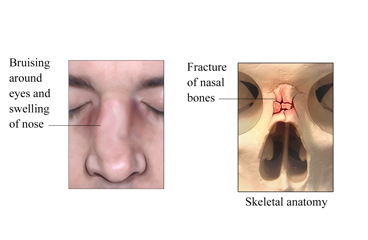
Overview
A broken nose is a break, or fracture, of the bone or cartilage. Most broken noses need only home care and a follow-up visit with a doctor. The swelling should go down in a few days. Bruises around your eyes and nose should go away in 2 to 3 weeks.
You heal best when you take good care of yourself. Eat a variety of healthy foods, and don't smoke.
Follow-up care is a key part of your treatment and safety. Be sure to make and go to all appointments, and call your doctor if you are having problems. It's also a good idea to know your test results and keep a list of the medicines you take.
How can you care for yourself at home?
- If you have a nasal splint or packing, leave it in place until a doctor removes it.
- If your doctor prescribed antibiotics, take them as directed. Do not stop taking them just because you feel better. You need to take the full course of antibiotics.
- Take decongestants as directed to help you breathe after the splint or packing is removed. Your doctor may give you a prescription or suggest over-the-counter medicine.
- Be safe with medicines. Take pain medicines exactly as directed.
- If the doctor gave you a prescription medicine for pain, take it as prescribed.
- If you are not taking a prescription pain medicine, ask your doctor if you can take an over-the-counter medicine.
- Put ice or a cold pack on your nose for 10 to 20 minutes at a time. Try to do this every 1 to 2 hours for the first 3 days (when you are awake) or until the swelling goes down. Put a thin cloth between the ice pack and your skin.
- Sleep with your head slightly raised until the swelling goes down. Prop up your head and shoulders on pillows.
- Ask your doctor when it's okay to return to your normal activities.
When should you call for help?
Call 911 anytime you think you may need emergency care. For example, call if:
- You have trouble breathing.
- You passed out (lost consciousness).
Call your doctor now or seek immediate medical care if:
- You have signs of infection, such as:
- Increased pain, swelling, warmth, or redness.
- Red streaks leading from the area.
- Pus draining from the area.
- A fever.
- You have clear fluid draining from your nose.
- You have vision changes.
- You have swelling or a bump on the thin wall (nasal septum) between the nostrils of your nose.
- Your nose is bleeding.
- You have new or worse pain.
Watch closely for changes in your health, and be sure to contact your doctor if:
- You do not get better as expected.
Where can you learn more?
Go to http://www.healthwise.net/patientEd
Enter Y345 in the search box to learn more about "Broken Nose: Care Instructions".
Current as of: July 10, 2023
Author: Healthwise Staff
Clinical Review Board
All Healthwise education is reviewed by a team that includes physicians, nurses, advanced practitioners, registered dieticians, and other healthcare professionals.

